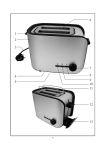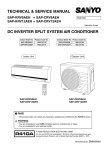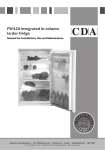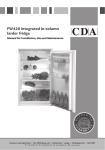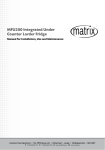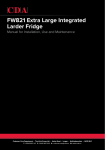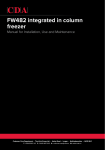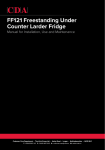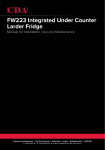Download CDA FW320 refrigerator
Transcript
FW320 integrated under counter larder fridge Manual for Installation, Use and Maintenance Passionate about style Customer Care Department • The Group Ltd. • Harby Road • Langar • Nottinghamshire • NG13 9HY T : 01949 862 012 F : 01949 862 003 E : [email protected] W : www.cda.eu INSTRUCTIONS FOR USE BEFORE USING THE REFRIGERATOR PROTECTING THE ENVIRONMENT PRECAUTIONS AND GENERAL RECOMMENDATIONS HOW TO USE THE REFRIGERATOR COMPARTMENT HOW TO USE THE LOW TEMPERATURE COMPARTMENT HOW TO DEFROST AND CLEAN THE LOW TEMPERATURE COMPARTMENT HOW TO CLEAN THE REFRIGERATOR COMPARTMENT CLEANING AND MAINTENANCE ENERGY SAVING TIPS TROUBLESHOOTING GUIDE AFTER-SALES SERVICE INSTALLATION ELECTRICAL CONNECTION BEFORE USING THE REFRIGERATOR In order to maximise the performance of your refrigerator, carefully read the user instructions and the attached product sheet, which provide useful food conservation tips and a description of the appliance. Keep this booklet for future reference. • The product you have purchased is an automatic refrigerator, or a refrigerator with a low temperature compartment (see attached product sheet), and is for domestic use only. The refrigerator compartment defrosts automatically and is used for the preservation of fresh foods and drinks. The low temperature compartment, if featured, is used for the conservation of deep-frozen and frozen foods and for making ice-cubes; defrosting is manual. 1. After unpacking, check the refrigerator for damage and make sure the doors close properly. Any damage must be reported to the retailer within 24 hrs of delivery. 2. Leave the appliance standing in a vertical position for at least 2 hours before connecting it to the power supply (to allow the refrigerant circuit time to settle). 3. Make sure that the installation and electrical connection are carried out by a qualified technician in compliance with the manufacturer’s instructions and local safety regulations. PROTECTING THE ENVIRONMENT 1. Packaging The packaging material is 100% recyclable, as confirmed by the recycling symbol. Follow local regulations for waste disposal. Keep potentially hazardous packaging (plastic bags, polystyrene, etc.) out of the reach of children. Information: This appliance is free of CFC’s (refrigerant circuit contains R134a) or free of HFC’s ( refrigerant circuit contains R600a - Isobutane). For more details, please refer to the rating plate on the appliance. 2. Product The refrigerator has been manufactured using recyclable materials. Follow local waste disposal regulations when scrapping. Cut off the power cable to prevent connection to the mains. Dispose of the appliance at your local recycling plant for refrigerant gases. PRECAUTIONS AND GENERAL RECOMMENDATIONS • Only use the refrigerator compartment to store fresh foods only and the low temperature compartment to store deepfrozen foods and making ice-cubes. • Do not cover or close the air vents. • Do not put glassware containers holding liquids in the low temperature compartment since they may explode. • Do not eat ice-cubes or ice-lollies immediately after taking them out of the low temperature compartment, since they may cause cold-burns. • To prevent the risk of trapping and suffocation, do not allow children to play or hide inside the refrigerator. • Before cleaning or servicing the appliance, always unplug it or switch off the mains power supply. • The power cable may only be replaced by authorized personnel. Declaration of conformity • This appliance is designed to store food products and complies with European Directive 89/109/EEC. For appliances with Isobutane (R600a) The refrigerant Isobutane is a natural gas of high environmental compatibility but which is inflammable. Therefore, it is essential to ensure that the ducts of the refrigerant circuit do not get damaged. HOW TO USE THE REFRIGERATOR COMPARTMENT This is an automatic refrigerator or refrigerator with star low temperature compartment. Refrigerator compartment defrosting is fully automatic. The refrigerator operates in an ambient temperature ranging from +16°C to +32°C. Switching on the refrigerator Insert the plug in the mains socket. The thermostat allows you to set the temperature inside the refrigerator compartment without altering the conditions inside the low temperature compartment. Setting the temperature: 1. For correct operation and excellent storage results in both compartments, set the thermostat between positions 2 and 3. 2. To set the temperature inside the compartments, turn the thermostat as follows: •1-2 for a WARMER TEMPERATURE. •3-4 for a COLDER TEMPERATURE. Thermostat set to z: position: the appliance and lighting switch off. Note: Ambient temperature, the frequency with which the doors are opened and closed and the position of the appliance can affect the temperature inside the two compartments. Adjust the thermostat accordingly. How to store food in the refrigerator compartment 1. Store the food as shown in the adjacent illustration. A Cooked food B Fish and meat C Fruit and vegetables D Bottles E Eggs F Butter, cheese and other dairy products Notes: • Make sure the air circulates freely between the shelves and the back wall of the refrigerator. • Do not store food against the back wall of the compartment. • Store liquids in sealed containers. • Vegetables with a high water content (e.g. lettuce) may cause condensation to form in the bottom drawers and/ or on the middle shelves; this does not affect the correct operation of the appliance. Nevertheless, it is advisable to wrap vegetables before storing. HOW TO USE THE LOW TEMPERATURE COMPARTMENT If installed, the star low temperature compartment may be used to store frozen products for the time indicated on the packaging. When purchasing deep-frozen foods, check the following: • That the packaging is intact, since the food may have deteriorated. If the package bulges or is marked by damp patches, the product has not been correctly stored and may have partially thawed. • Purchase deep-frozen foods last and use insulated bags for transportation. • Place items in the low temperature compartment as soon as you get home. • Consume partially thawed food within 24 hrs. • Avoid temperature variations as much as possible. Observe the “best before” date on the packaging. • Observe the instructions for preserving deepfrozen foods written on the packaging. How to make ice-cubes • Fill the ice-tray 3/4 full of water and place it in the bottom of the low temperature compartment. If the ice-tray sticks to the bottom, do not use pointed or sharp instruments to detach it. HOW TO DEFROST AND CLEAN THE LOW TEMPERATURE COMPARTMENT To maximise performance, defrost the low temperature compartment at least twice a year, or when the layer of ice on the walls reaches 3 mm thickness. Defrost the compartment when the contents are low. 1. Open the door and take out all food items, wrapping them in newspaper and placing them together in a cool place or in an insulated bag. 2. Unplug the appliance from the mains. 3. Leave the door open to allow the frost/ice on the compartment walls to melt. 4. Remove the defrost water with a sponge. 5. Clean with a sponge soaked in a solution of lukewarm water and neutral detergent. Do not use abrasive substances. 6. Rinse and dry thoroughly. Note: to avoid causing irreparable damage, do not use pointed or sharp metal instruments to scrape off ice and do not artificially heat the low temperature compartment. HOW TO CLEAN THE REFRIGERATOR COMPARTMENT Clean the refrigerator compartment regularly. Refrigerator compartment defrosting is fully automatic. The formation of water droplets on the rear internal wall of the refrigerator compartment indicates that the automatic defrosting is underway. Defrost water is channelled to a runoff and collected in a container, where it evaporates. Clean the run-off channel regularly, using the supplied instrument, in order to guarantee a continuous outflow of defrost water. Before cleaning, unplug the appliance from the mains. • Use a sponge soaked in lukewarm water and/or neutral detergent. • Rinse and dry with a soft cloth. Do not use abrasive materials. CLEANING AND MAINTENANCE • Clean the air vents regularly with a vacuum cleaner or a brush. • Clean the exterior with a soft cloth. Prolonged disuse 1. Empty the refrigerator and low temperature compartments. 2. Unplug the appliance from the mains. 3. Defrost the low temperature compartment, clean and dry both compartments. 4. Leave the doors open to prevent the formation unpleasant odours. ENERGY SAVING TIPS • Do not expose the appliance to heat sources, direct sunlight, etc., since this will increase energy consumption. • Do not cover the vents or air outlets. • When thawing food items, place them in the refrigerator compartment to make use of the low temperature. • Keep the door open as little as possible. • Do not put food in the refrigerator when still hot. • Do not leave the low temperature compartment door open. TROUBLESHOOTING GUIDE 1. The appliance does not work. •Is there a power failure? •Is the plug properly inserted in the socket? •Is the double-pole switch on? •Has the fuse blown? •Is the thermostat set to z (Stop)? 2. Temperature inside the compartments is not cold enough. •Do the doors close properly? •Is the appliance installed near a heat source? •Is the thermostat correctly set? •Is air circulation inhibited? 3. The temperature inside the refrigerator compartment is too cold. •Is the thermostat correctly set? 4. Water collects in the bottom of the refrigerator compartment. •Is the defrost water run-off clogged? 5. The internal light does not work. First refer to point 1, and then: •Unplug the appliance from the mains power supply. •Refer to the instructions and illustration on the enclosed sheet to access the light-bulb. •Check the bulb and replace if necessary. (E14 type, 15W max). 6. Excessive formation of frost/ice in the low temperature compartment. •Is the low temperature compartment door properly closed? Notes: • Gurgling or hissing noises inside the refrigerating circuit are quite normal. AFTER-SALES SERVICE Before contacting our After-Sales Service: 1. Try to remedy the problem (see “Troubleshooting guide”). 2. Restart the appliance to see if the fault repeats. If the fault persists, switch off the appliance and switch on again after an hour. 3. If the fault still persists, contact the After-Sale Service and specify the following: •the nature of the problem •the model •the service number (the number after SERVICE on the rating plate located on the side of the fruit and vegetable drawer) •your full address •your telephone number plus area code. Note: changes to the door opening direction carried out by our Customer Service are not covered in the terms of the guarantee. INSTALLATION • Do not install the appliance near a heat source (minimum distances: 30 cm from solid fuel or gasoil stoves, 3 cm from electric ovens and hobs). • Install the appliance in a dry and wellventilated place. • Do not cover the air vents. • Clean the appliance interior (see relevant chapters). • Mount the accessories. ELECTRICAL CONNECTION • Electrical connections must be made in accordance with local regulations. • Voltage and absorption rates are indicated on the rating plate. • The appliance must be earthed as prescribed by law. The manufacturer declines all liability for personal injury or damage to property or animals resulting from failure to comply with the above requirements. • If the appliance plug and wall socket are incompatible, the socket must be replaced by a qualified electrician. • Do not use extension leads or multiple adapters. ELECTRICAL DISCONNECTION • It must be possible to disconnect the appliance from the mains by removing the plug or by disconnecting a two-pole circuit breaker. Electrical information Warning! This appliance must be earthed. The mains lead of this appliance has been fitted with a BS 1363A 13 amp fused plug. To change a fuse in this type of plug, follow the steps below: 1. Remove the fuse cover and fuse. 2. Fit replacement 13A fuse, ASTA approved to BS 1362 type, into the fuse cover. 3. Replace fuse cover. Important: Do not use the appliance without the fuse cover in position. How to connect an alternative plug If the fitted plug is not suitable for your socket outlet, then it should be cut off and disposed of safely to avoid possible shock hazard. A suitable alternative plug of at least 13 Amp rating to BS 1363 should be used. As the colours of the wires in the mains lead of this appliance may not correspond with the coloured markings identifying the terminals in your plug, proceed as follows:• The wire which is coloured GREEN and YELLOW must be connected to the terminal which is marked with letter (E) or by the Earth symbol or coloured GREEN and YELLOW. • The wire which is coloured BLUE must be connected to the terminal which is marked with the letter (N), or coloured BLACK. • The wire which is coloured BROWN must be connected to the terminal which is marked with the letter (L) or coloured RED. If in doubt regarding the electrical connection of this appliance, consult a qualified electrician. Do not shorten the supply cable, the appliance may require removing for servicing. N.B. Ensure that the plug socket is situated in an easily accessible place. Notes : Notes : Notes : To contact our Customer Care Department, or for Service, please contact us on the details below. Passionate about style Customer Care Department • The Group Ltd. • Harby Road • Langar • Nottinghamshire • NG13 9HY T : 01949 862 012 F : 01949 862 003 E : [email protected] W : www.cda.eu













